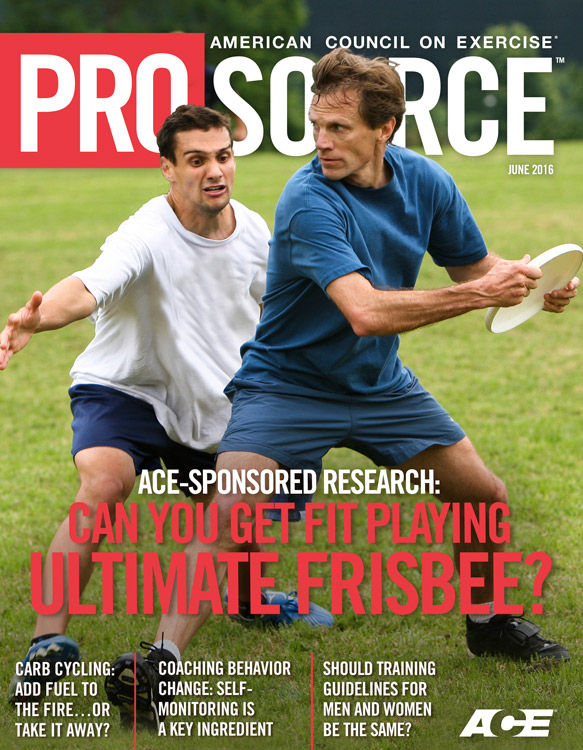
At a time when information can be shared with countless people with just the push of a button, it’s no surprise that more and more health and fitness professionals are turning to the web as a way to share their passion and their knowledge with the world at large. But in such a crowded content space, what makes a great health and fitness blog, and more importantly, what is your intention behind establishing this type of presence online? No matter what your motivations may be, if you’ve been considering making the leap into the world of blogging, now is the time to get started.
Start Where You Are
When it comes to blogging, there’s no one-size-fits-all approach to embark on this new endeavor. In fact, your personal journey and experiences can and should play a defining role in guiding the direction and focus of your blog. For certified personal trainer Erin Bahadur, her blog, Erin’s Inside Job, came about as part of her own recovery and self-discovery process.
“I started my blog in 2013, a couple of years into my recovery from drug and alcohol addiction,” shares Bahadur. “I felt it was important to share the lessons I had learned about myself through that process, information which was universal to both people in recovery as well as those who were not.”
While Bahadur’s blog has always focused on well-being, it took nearly two years for her to narrow down the specific subjects she now writes about, given her own evolving view of health during that time.
“Initially I wrote a lot about running because it was important to my personal growth and served as a way to stay accountable and to process certain things,” notes Bahadur. “Yet over time I realized that true wellness comes from within, and I had a larger opportunity to teach others about addiction, self-care and finding a sustainable way to live a healthy life, which includes taking care of your physical, mental, emotional and spiritual health.”
For others, like certified personal trainer Kasey Arena, a blog may start with a very specific focus based on a particular passion or area of interest.
“My blog, Powercakes.net, started in 2010 when I was a junior in college as an outlet for me to share my recipes with family and friends given my passion for cooking and baking,” shares Arena. “The name of the blog actually comes from my mom adding protein to our pancakes when we were kids and calling them “powercakes.” Little did I know that this outlet would in time turn into such an amazing addition to my journal of life.”

Over the past six years the content of Arena’s blog has evolved just as she has, both personally and professionally, ultimately serving as an outlet for her to share her personal story of disordered eating, over-exercising, body image issues and self-love, in addition to providing information about food, fitness and finding balance among the many facets of everyday life.
If you find yourself compelled to start a blog, but feel unsure of what exactly to hone in on, Bahadur suggests thinking about how your experiences might help someone else. “You’d be surprised at how many people respond and relate to practical advice on how to get through situations and how to reach specific goals,” she says.
If you’re still feeling uncertain about how exactly to break in to the world of blogging, Arena offers her personal motto and most valuable piece of advice—be true to you. “I honestly believe 100 percent in being true to yourself,” says Arena. “Since the beginning I’ve always been honest with my personal ups and downs on the blog, and I think that is why readers come back and feel connected to me and my story. At the end of your day, your story is everything, and you never know who you will impact just by being honest with who you are and what you’re going through.”
The Makings of a Great Blog
In a world saturated with online content, utilizing your authentic voice to deliver quality information consistently is key, says certified strength and conditioning coach Tony Gentilcore, who has blogged for sites such as the Boston Herald and T-Nation over the past 10 years.
“If you put out good, consistent content that is entertaining, eventually it will be read,” shares Gentilcore. “Think of the content on your blog as ‘infotainment’—to keep people’s attention for 500 to 1,000 words, the content you provide should be informative, while also reflecting your personality.”

Whether he is crafting content for his personal blog on TonyGentilcore.com or authoring content for Men’s Health, Gentilcore hones in on his areas of expertise and crafts the content as if he is sharing the information with just one person. “When I’m writing I always ask myself: What is the purpose behind this post? Why am I writing this?” explains Gentilcore. “I’m also not afraid to let my personality come through in my writing, as that is something my readers have come to appreciate about my posts over the years.”
Bahadur also allows her unique voice and personality to shine through in her posts, so that people can get a better sense of who she is through her writing. “While some posts are more serious than others, I try to use humor to lighten up certain subjects because that is what comes naturally to me,” shares Bahadur.
While witty comments can make for an interesting and entertaining read, it’s important that whatever you choose to incorporate into your writing is authentic to you. “I firmly believe in writing to your strengths and staying in your lane,” notes Gentilcore. “That means you shouldn’t feel compelled to write about topics that you are not knowledgeable and passion about, and don’t feel the need to use humor or to quote other people if that is not your personal style.”
Although well-written content is central to the success of any blog, visual elements such as photos and videos can add another dimension that can help distinguish your content from other similar posts, especially on social media platforms like Instagram and Pinterest. Bahadur uses a consistent style of photography for all of her blog’s imagery, so that when people see the images they immediately associate them with her brand.
Arena also chooses to place additional focus on imagery, turning to technology to help her posts truly stand out. “I’m a hugely visual person, so the more eye-catching the picture, the better,” says Arena, who has been growing a dedicated following on Instagram since the time the app first launched. “I personally like using fun photo editing tools, like the Camera+ app, Videoshop for video editing, and PicCollage for collages.”
While great imagery serves any blog well, it tends to play an even more pivotal role if your content centers on recipes or exercise ideas. Certified personal trainer Tina Haupert knows this all too well from the last eight years she’s spent evolving her lifestyle blog Carrots ‘N’ Cake, which focuses on food, family and fitness. Although her blog originally began as a personal online journey of her meals and workouts leading up to her wedding day—something she never intended for other people to read—today Haupert has a strong following of loyal readers. She utilizes social media to continue to bring new readers to her site, which is where she’s discovered just how valuable the visual elements of a post can be. “I’m still working on this myself, but promoting your work via Pinterest is huge for getting new readers to your blog, so it’s worth taking the time to make attractive images to encourage others to find and pin them,” says Haupert.
How to Measure Your Blog’s Performance
The success of a blog can be measured in many different ways, from tracking page views and time spent on each page, to monitoring the number of comments, new subscriptions and shares on social media. For those seeking a more formal assessment, Google Analytics offers an objective and in-depth analysis of how well your content is performing based on a multitude of different metrics. Additionally, if you plan to share content and promote your blog via email, you can access valuable data such as open rates and click through rates through email marketing services, such as Mailchimp.
Given the integral role social media plays in growing a blog, if you’re interested in assessing your overall impact online, Klout is a site worth considering, as it uses social media analytics to evaluate your online influence, which includes identifying the most widely shared posts across your respective social media platforms.
Regardless of how you choose to evaluate and define success, Haupert cautions new bloggers not to get too caught up in the data, as a great blog takes time to build. “Don’t get frustrated if you don’t see it grow right away,” says Haupert. “It takes a lot of work, time (often years) and patience to see real growth.”
Strategies for Getting Started
If you’ve considered starting a blog, the best advice successful bloggers have to offer is just simply to get started.
“I’ve learned through my years of blogging that there is no magic pill when it comes to having a successful blog,” shares Arena. “Start simple and, most importantly, don’t overthink it—the best content often comes from your innate passion and staying true to who you are.”
Gentilcore fully agrees that the best way to get starting with blogging is to take some type of action today. “People ponder and pontificate far too much over whether they should or shouldn’t start a blog,” notes Gentilcore.” My advice is don’t keep talking about or asking about how to do it—just start doing it.”
To get inspired to put pen to paper—or in reality, to put fingers to keys—Gentilcore suggests reading the content of other bloggers whose writing styles you like, focusing not on the subject matter but rather on the actual structure and approach to their writing and why it resonates with you.
Next, consider whether you will utilize an established blog publishing service or whether you’ll self-host on your own website. Many successful bloggers, including Arena, Bahadur and Gentilcore, started simple with a free blog on the established blog publishing platform Blogger. As their blogs organically grew over time, they each made the switch over to self-hosting, through sites such as WordPress.com and WordPress.org.
The simplicity of a site like Blogger, and the fact that it is free, makes getting started with blogging that much easier, especially if you’re not considering monetizing your work in the future. However, Bahadur wishes she had started self-hosting from the beginning.
“When I started my blog, I just wanted to get my emotions and experiences out there, and I didn’t have any grand plans of monetizing or growing it into anything specific, so I assumed I wouldn’t need anything more than a free site,” shares Bahadur. “Ultimately I ended up going from Blogger to WordPress.com to WordPress.org in a little over six months, and during that time there were migration headaches, broken links and wonky formatting that I still have to go back and fix at some point. Being self-hosted has allowed me to take my blog to a different level, and I only wish I had done it sooner.”
Bahadur’s advises prospective bloggers to take some time to think about where you want your blog to go, and to trust in yourself and your abilities if you aspire to grow your blog beyond just an online journal. “If you have even the smallest inclination to grow your blog, I would suggest making the investment sooner rather than later.” The good news is with the ability to secure a domain name for about $10 a year and to also create and design your own personal website—blog included—with free and low-cost drag-and-drop web hosting services like Weebly.com and Wix.com, self-hosting isn’t limited to the super tech-savvy.
Building Your Following
Monetizing Your Content
When starting a blog, it’s important to manage expectations regarding creating a revenue stream from your writing. While it is certainly possible to make money blogging, Gentilcore points out that there are other valuable forms of compensation other than money.
“Your blog can serve as a great way to establish your personal brand, and writing guest posts for other sites, even when unpaid, offers great value and compensation in the form of name recognition and prospective new readership for your blog,” says Gentilcore.
In terms of creating an additional stream of income, Bahadur features ads, affiliate links and sponsored posts on her site, the last of which serves as her main income source. Arena also features some affiliate links on her site, but she primarily monetizes her content by partnering up with different brands on recipe formulation, workout creations, pinnable images, giveaways and other campaigns on social media, in addition to being well-connected in the broader blogging community.
“I personally belong to FitFluential which is a great way to connect with brands and others bloggers in the influential fitness space,” shares Arena. “I’m also on TapInfluence where you can connect with brands for paid opportunities based on your reach.”
To get more connected in the blogging community and to start spreading the word about your blog once it’s up and running, Haupert suggests strengthening your overall presence on social media, building a network of other bloggers and social media friends to get your name out there and to make your personal brand and blog known. “Find like-minded people, use appropriate hashtags in your posts, comment often and start conversations,” shares Haupert.
If you fear that blogging is something that won’t fit into your already busy schedule, know that you can establish an approach to blogging that serves you best. The key is to consistently produce great content and stay connected with your community. When Arena first started blogging, she assumed it had to be a seven-days-a-week job, which is something that was not feasible for her given her busy personal-training schedule.
“I quickly got burnt out and had to find a balance that works for me personally,” says Arena, “which I have found is a combination of 'micro blogging' on Instagram, which I post to at least once a day to highlight my day or to link to my most recent blog posts. I also put together a detailed schedule, complete with goal dates by which to have my posts written and posted for my actual blog.”
Gentilcore opts to post to his personal blog an average of three to five times per week, which fits his schedule best given his work as a strength and conditioning coach and as a writer for other websites and publications.
“Consistency is key, so I make time in the morning throughout the week, usually between the hours of 8 and 10am, to write posts for my personal blog, which I have placed more and more priority on over the years,” shares Gentilcore.
Bahadur estimates that on average she spends three to four hours per day on her blog, either in one continuous bout or during times throughout the day, depending on what fits her schedule. “The time I spend on my blog includes answering and sending emails related to my blog, editing photos, creating graphics, writing a post, scheduling social media posts (Bahadur recommends automating this as much as you can using a social media scheduler like HootSuite), reading and commenting on similar blogs and responding to blog comments, among other things.”
For others, blogging does become a full-time job. Haupert, for example, acknowledges there’s always work to be done on the blog. “I can honestly say that I never stop working, as I’m either blogging, updating some sort of social media, replaying to emails, negotiating rates for projects, invoicing or brainstorming and taking notes for upcoming projects all day long,” shares Haupert. “I work harder as a blogger than I ever did at any other full-time job.”
No matter how you choose to approach your blog, be prepared for the professional opportunities this new endeavor may eventually provide. For both Gentilcore and Arena, their years of diligent blogging have led each to become a published author. As for Bahadur, her writing has landed her a spot as a blogger for Huffington Post, and she has also been invited to serve as keynote speaker at an upcoming marketing conference later this month.
“You really have nothing to lose when it comes to blogging,” says Haupert. “Just be yourself, do your thing, and in time your readers will appreciate what makes you special and unique.”





 by
by 




